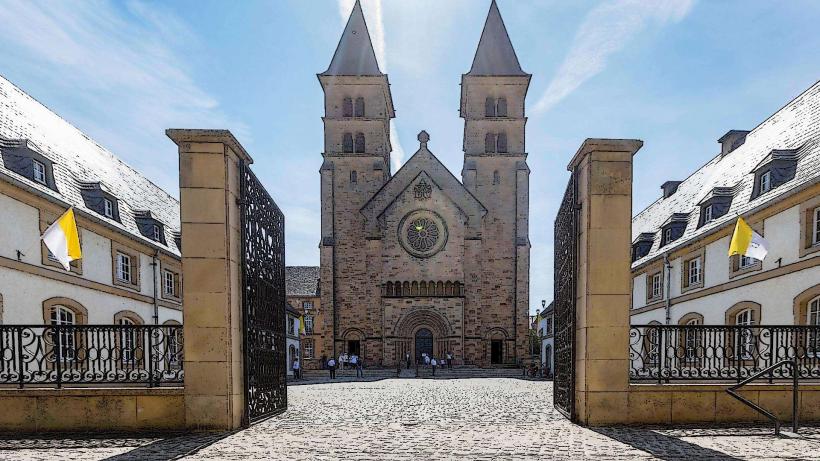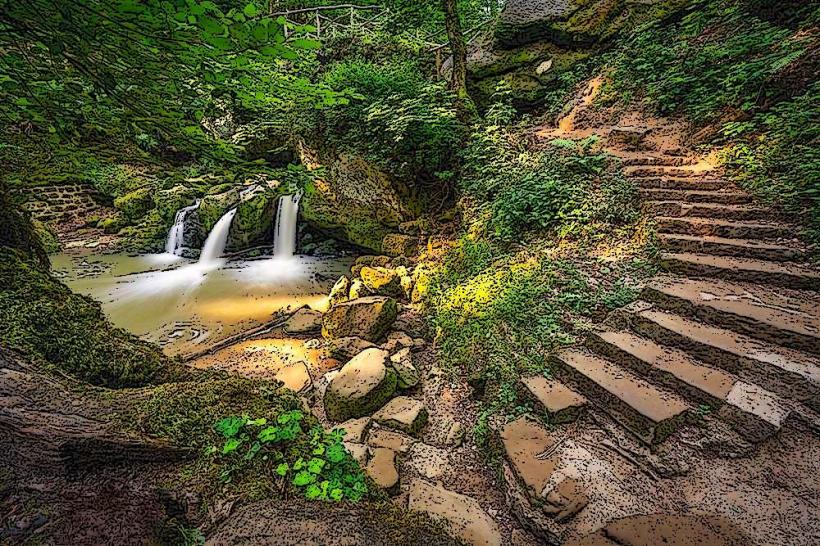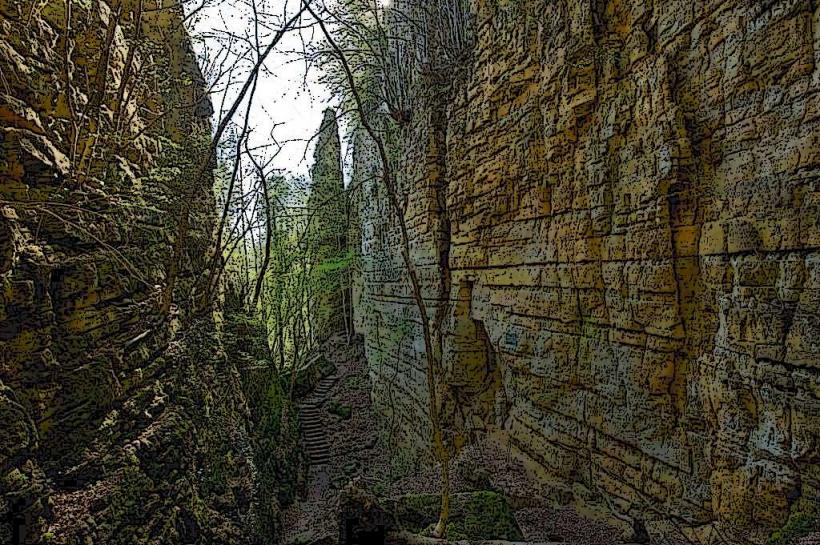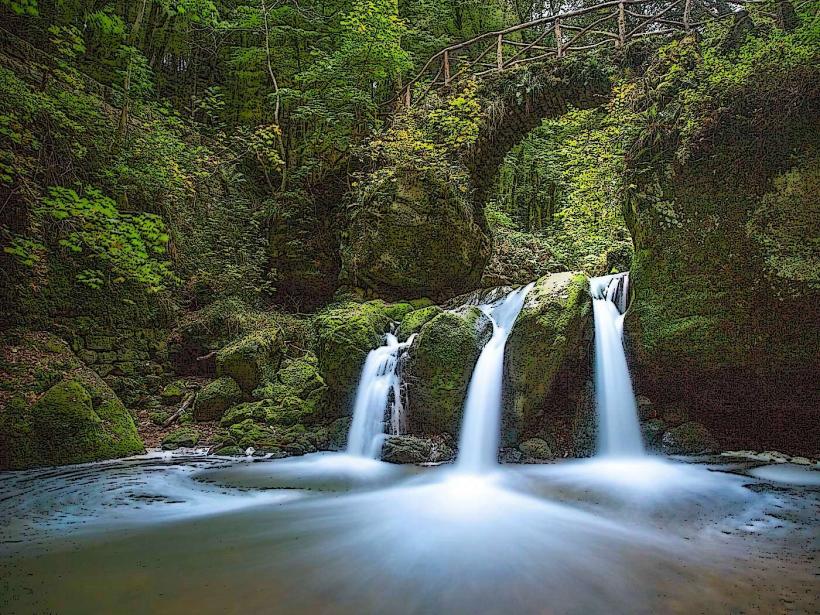Information
Landmark: Heringer MillenCity: Echternach
Country: Luxembourg
Continent: Europe
Heringer Millen (also known as Heringer Mill) is a historic watermill located in the Mullerthal Region of Luxembourg. It is an important cultural and historical landmark, providing a glimpse into the traditional rural life and milling practices of the region. The mill is situated near the village of Berdorf, close to the picturesque Mullerthal Trail, making it an accessible and interesting stop for those exploring the area's natural beauty.
Key Features of Heringer Millen:
1. Historical Significance:
- The Heringer Mill dates back to the 18th century, with a long history of serving as a grain mill for the local community. Like many mills of its time, it played a crucial role in the local economy by grinding grains such as wheat and rye into flour.
- Over the years, the mill has been carefully preserved, and its traditional architecture remains largely intact, offering visitors a rare insight into the craftsmanship and engineering of historic watermills in Luxembourg.
- The mill was once part of a larger network of watermills that dotted the region, powered by the nearby streams and rivers that were harnessed for mechanical work.
2. The Mill and its Function:
- The mill is powered by water from the Sauer River, which runs through the region. The waterwheel harnesses the river's flow to operate the mill's grinding machinery, which was historically used to process local crops.
- The mill remains functional in its traditional form, and visitors can see the working mechanisms, including the large waterwheel, grinding stones, and other equipment used in the milling process.
- In addition to its milling history, the mill has been used for educational purposes, with demonstrations and displays explaining the milling process and the historical importance of such watermills.
3. Cultural and Educational Aspects:
- Today, Heringer Millen is a cultural heritage site, where visitors can learn about the traditional methods of milling, the history of the area, and the development of the local agricultural economy.
- The mill has an educational role for visitors, especially those interested in traditional rural techniques and the history of industrial mills in Luxembourg. It often hosts exhibitions and events that showcase the region's heritage.
- Workshops and demonstrations on milling techniques may be available, allowing visitors to see the watermill in action. It provides a great opportunity to understand the role of mills in rural economies, especially before the advent of modern industrial processes.
4. Location and Scenic Surroundings:
- Heringer Millen is nestled in a picturesque setting, surrounded by forests, rock formations, and rolling hills. It is part of the Mullerthal Region, which is often referred to as Luxembourg’s Little Switzerland due to its dramatic landscapes.
- The mill is easily accessible from the nearby Berdorf village and is a popular stop for hikers on the Mullerthal Trail. The surrounding area features rocky paths, gorges, and wooded hillsides, creating a beautiful and tranquil environment for visitors to explore.
- The Sauer River nearby adds to the scenic beauty, and visitors can enjoy walking along the riverbanks or through the nearby forests, offering a peaceful retreat into nature.
5. Architecture and Design:
- The Heringer Mill showcases traditional Luxembourgish architecture, with its stone structure, wooden waterwheel, and other rustic elements that highlight the craftsmanship of the time.
- The mill’s design reflects the practical needs of a working mill, with storage rooms, grinding chambers, and mechanical equipment that allow visitors to step back in time and see how flour was produced.
- The surrounding buildings and outbuildings also offer a glimpse into the rural lifestyle, with structures that were once used for storage, animal housing, or other agricultural purposes.
6. Practical Information:
- Location: Heringer Millen is located near the village of Berdorf, about 10 km north of Ettelbruck and is easily accessible from other locations in the Mullerthal Region.
- Opening Hours: The mill is generally open to visitors year-round, though it is advisable to check for specific opening hours and any special events or workshops before visiting.
- Facilities: There are no extensive facilities at the mill itself, but visitors can find nearby cafes, restaurants, and accommodations in the surrounding towns, such as Berdorf or Ettelbruck.
- Guided Tours: Some tours or demonstrations may be available to provide more in-depth knowledge about the mill's history and operations.
- Parking: There is typically parking available near the mill or in the nearby village, making it easy to access the site.
7. Nearby Attractions:
- Mullerthal Trail: The mill is located along the Mullerthal Trail, one of Luxembourg’s most popular hiking routes. The trail offers beautiful walks through forests, past dramatic rock formations, and along picturesque streams.
- Berdorf: The nearby village of Berdorf is a charming town with traditional Luxembourgish architecture and is known for its proximity to scenic natural sites such as the Schiessentümpel Waterfall and Wolfsschlucht (Wolf’s Gorge).
- Ettelbruck: A short drive away, Ettelbruck is a larger town with historical sites, museums, and cultural attractions, offering visitors additional opportunities for sightseeing.
Conclusion:
Heringer Millen is a fascinating historical site in the Mullerthal Region, offering visitors a unique chance to experience traditional milling techniques and explore the cultural heritage of Luxembourg. Surrounded by beautiful natural landscapes, it provides an educational and scenic stop for hikers, history buffs, and nature lovers alike. Whether you're interested in learning about the milling process or simply enjoying the tranquil surroundings, Heringer Millen is a memorable destination.





